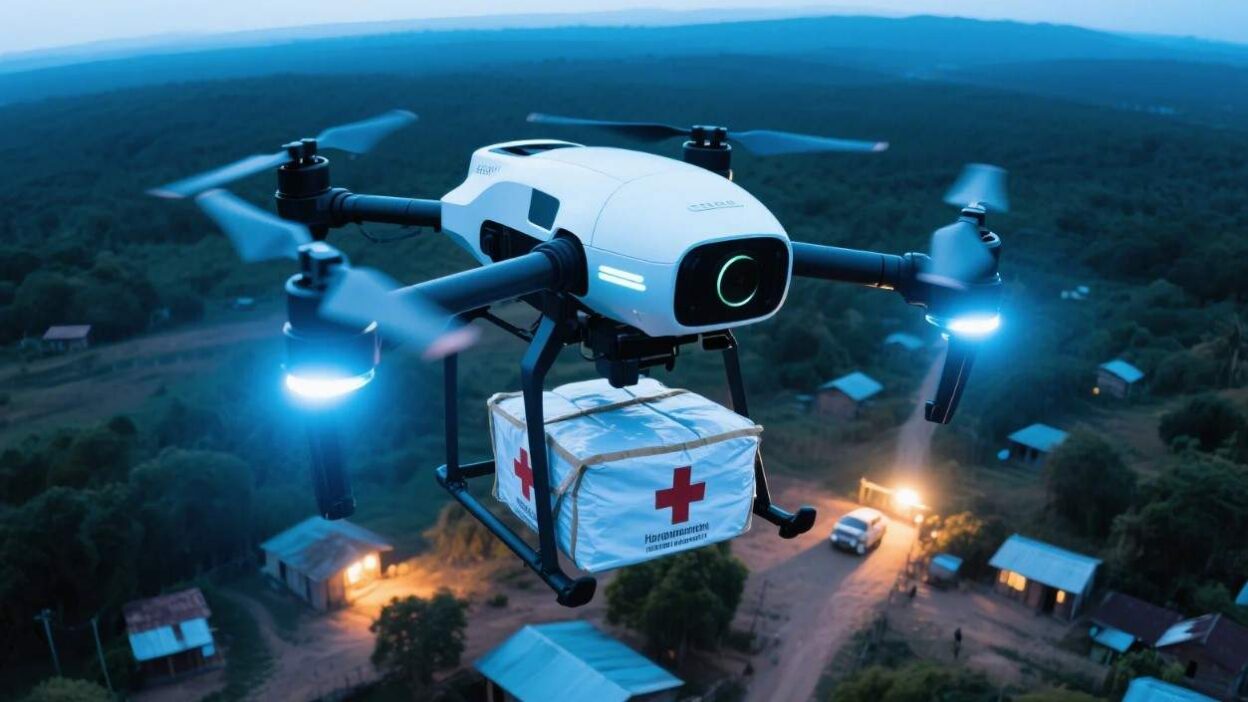The Unreachable Crisis – Why Remote Areas Need Drones
In the wake of natural disasters, conflicts, or pandemics, remote regions—whether mountainous villages, isolated islands, or conflict zones—often bear the brunt of suffering. Traditional humanitarian aid, reliant on ground transport, helicopters, or ships, faces insurmountable barriers: blocked roads, damaged infrastructure, or sheer geographic inaccessibility. For communities cut off from the outside world, delays in aid delivery can mean the difference between life and death.
Enter autonomous drones—unmanned aerial vehicles (UAVs) equipped with AI, GPS, and sensors—that are redefining humanitarian aid. These drones navigate without real-time human control, delivering supplies, mapping disaster zones, and assessing needs in hours, not days. This article explores how autonomous drones are transforming aid in remote areas, their unique capabilities, and the challenges and opportunities they present.
Autonomous Drones: The Technology Behind the Lifeline
Autonomous drones are more than just flying robots—they are sophisticated systems integrating cutting-edge technology to operate in complex environments. Key components include:
- Navigation Systems: GPS, inertial measurement units (IMUs), and visual-inertial odometry (VIO) enable drones to fly precise routes, even in areas with poor GPS coverage (e.g., dense forests or urban canyons).
- Sensors and Payloads: Multispectral cameras, thermal imaging, and LiDAR (light detection and ranging) capture critical data, while modular payloads (e.g., cargo bays, medical kits) allow tailored mission configurations.
- AI and Machine Learning: Algorithms process real-time data to adjust flight paths, avoid obstacles, and prioritize delivery sites based on urgency (e.g., prioritizing hospitals over storage facilities).
For example, the Zipline drone, used in Rwanda and Ghana, can fly 160 km on a single charge, carry 1.8 kg of medical supplies, and navigate around trees or power lines using obstacle-avoidance tech.
Applications: How Drones Deliver Aid in Remote Areas
Autonomous drones are not just delivery vehicles—they are multi-tool assets that address diverse humanitarian needs:
1. Emergency Supply Delivery
Remote communities often lack access to basics like food, water, and medicine. Drones bridge this gap by:
- Delivering Critical Supplies: In 2023, during the Turkey-Syria earthquake, drones transported insulin, bandages, and clean water to villages buried under rubble, reaching survivors 48 hours faster than ground teams.
- Replenishing Stockpiles: Drones resupply remote clinics or disaster shelters with medicines, reducing reliance on slow, costly airlifts.
2. Disaster Mapping and Assessment
After a disaster, drones map affected areas to identify:
- Damage Zones: Thermal imaging detects hotspots (e.g., fires, collapsed buildings) or cold spots (e.g., flooded areas).
- Needs Hotspots: AI analyzes imagery to prioritize regions with the highest concentration of displaced persons or infrastructure damage.
In 2017, after Hurricane Harvey, drones surveyed 10,000+ square miles of flooded Texas, providing real-time data to redirect rescue teams to submerged neighborhoods.
3. Search and Rescue Operations
Drones enhance search efforts by:
- Locating Survivors: Thermal cameras detect body heat in rubble or dense vegetation, while loudspeakers broadcast rescue instructions.
- Delivering Emergency Kits: Drones drop life jackets, first-aid supplies, or communication devices to stranded individuals.
In Nepal’s 2015 earthquake, drones helped locate 200+ survivors trapped in remote mountain villages, cutting rescue time from days to hours.
4. Communication and Connectivity
In areas with no cell service, drones act as temporary communication hubs:
- Relay Networks: Drones equipped with 4G/5G modems connect first responders, government agencies, and affected communities.
- Broadcasting Alerts: Drones send SMS or voice messages warning of dangers (e.g., landslides, disease outbreaks) to remote populations.
Benefits: Why Drones Outperform Traditional Methods
Autonomous drones offer transformative advantages over conventional aid delivery:
1. Speed and Timeliness
Drones reach remote areas in hours, compared to days or weeks for ground or helicopter deliveries. During the 2022 Pakistan floods, drones delivered 500+ kg of food and medicine to 200 villages in 48 hours—critical before monsoon rains worsened flooding.
2. Cost-Effectiveness
Drones reduce operational costs by 60–80% compared to helicopters or cargo planes. A 2021 study by Drones for Good found that delivering 1 kg of supplies via drone costs 5, versus 100 by helicopter.
3. Safety for Responders
Drones avoid dangerous environments—avalanches, radiation zones, or conflict zones—protecting human aid workers. In Ukraine, drones deliver medical supplies to frontline hospitals in areas under bombardment, keeping medics out of harm’s way.
4. Scalability
Swarm drones—groups of coordinated UAVs—can deliver tons of supplies to large regions. In 2023, a swarm of 50 drones in Mozambique delivered 2 tons of rice to flood-affected communities, supporting 10,000+ people.
Challenges: Navigating the Path to Widespread Adoption
Despite their potential, autonomous drones face significant hurdles:
1. Technical Limitations
- Battery Life and Range: Most drones have a 1–2 hour flight time and 50–200 km range, limiting their reach in vast regions.
- Payload Capacity: Heavy or bulky supplies (e.g., water, construction materials) require larger drones, which are less agile.
2. Regulatory and Legal Barriers
Airspace restrictions, privacy laws, and export controls vary globally. For example, in India, commercial drone flights require prior approval, delaying emergency deployments.
3. Environmental and Weather Risks
Strong winds, rain, or extreme temperatures can ground drones. In the Amazon, heavy rainfall often disrupts drone operations, hindering aid delivery during monsoon seasons.
4. Ethical and Privacy Concerns
Drones raise concerns about surveillance and data privacy. In refugee camps, aerial imagery could inadvertently expose vulnerable populations to exploitation.
Case Studies: Drones in Action
- Rwanda’s Zipline Network: Zipline’s drones deliver 200,000+ medical packages annually to 12 million people in Rwanda and Ghana, including vaccines, blood, and emergency drugs. In 2020, during COVID-19, drones transported 1 million doses of vaccine to remote clinics.
- Ukraine’s Frontline Aid: Drones like the DJI Matrice 300 deliver insulin, antibiotics, and food to hospitals in Donetsk and Luhansk, where roads are controlled by Russian forces.
- Australia’s Bushfire Response: Drones mapped fire fronts in 2019–2020, identifying “firebreak” gaps and directing water bombers to critical areas, saving 300+ homes.
The Future: Innovations Shaping Humanitarian Drone Aid
The next frontier for autonomous drones in humanitarian aid lies in innovation:
- Long-Range, Heavy-Lift Drones: Companies like Wingcopter are developing drones with 500+ km range and 10+ kg payloads, enabling cross-continental deliveries.
- AI-Driven Autonomy: Machine learning will enable drones to predict disaster impacts (e.g., flood paths) and pre-position supplies, reducing response time further.
- Swarm and Collaborative Drones: Swarms of 100+ drones will coordinate to deliver large-scale aid, while collaborative systems (e.g., drones + ground robots) will enhance last-mile delivery.
- Sustainable Design: Biodegradable materials and solar-powered drones will reduce environmental impact, aligning with climate goals.
Drones as a Lifeline for Remote Communities
Autonomous drones are not just a technological novelty—they are a lifeline for communities in crisis. By overcoming geographic, logistical, and safety barriers, these drones deliver aid faster, cheaper, and more safely than ever before.
Yet, their full potential hinges on addressing technical, regulatory, and ethical challenges. As the world grapples with climate change, conflicts, and pandemics, investing in drone technology—and the policies to support it—will ensure that no community is left behind.
As humanitarian aid expert Dr. Paul Spiegel once said, “The best aid is the aid that arrives in time.” With autonomous drones, we are finally making that a reality for the world’s most remote and vulnerable.



